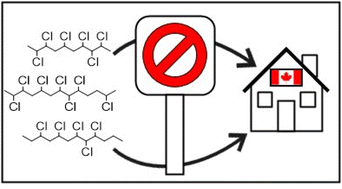Widespread presence of chlorinated paraffins in consumer products†
Abstract
Short-chain chlorinated paraffins (SCCPs) were listed for elimination under the Stockholm Convention in 2017 due to their persistence and toxicity. Although Canada and other Stockholm signatories have prohibited the manufacture, usage and import of SCCPs since 2013, they can still be detected at high concentrations in indoor dust. To identify the sources of the SCCPs in the Canadian indoor environment, short-, medium- and long-chain chlorinated paraffins (SCCPs, MCCPs, LCCPs, respectively) were measured using a sensitive LC-ESI-orbitrap method. SCCPs were detected in 84 of the 96 products purchased in Canada after 2013 (87.5%) including electronic devices, clothing, plastics (toys), and paintings. Concentrations of SCCPs were up to 0.93% (9.34 mg g−1). SCCPs were also detected in newly purchased toys at 0.005–2.02 mg g−1, indicating the potential for children's exposure. Profiles of chlorinated paraffins differed among categories of products. For example, C13-SCCPs were most common in toys, while electronic devices like headphones showed comparable concentrations of SCCPs and MCCPs. Additionally, four new carboxylate derivatives of CPs were detected in an electronic device sample. These are the first data to show the ubiquitous occurrences of SCCPs in a wide range of products currently marketed in Canada, suggesting continuing indoor exposure to SCCPs despite their prohibition.

- This article is part of the themed collections: Recent Open Access Articles, Contaminant remediation and fate and Outstanding Papers 2023 – Environmental Science: Processes & Impacts


 Please wait while we load your content...
Please wait while we load your content...